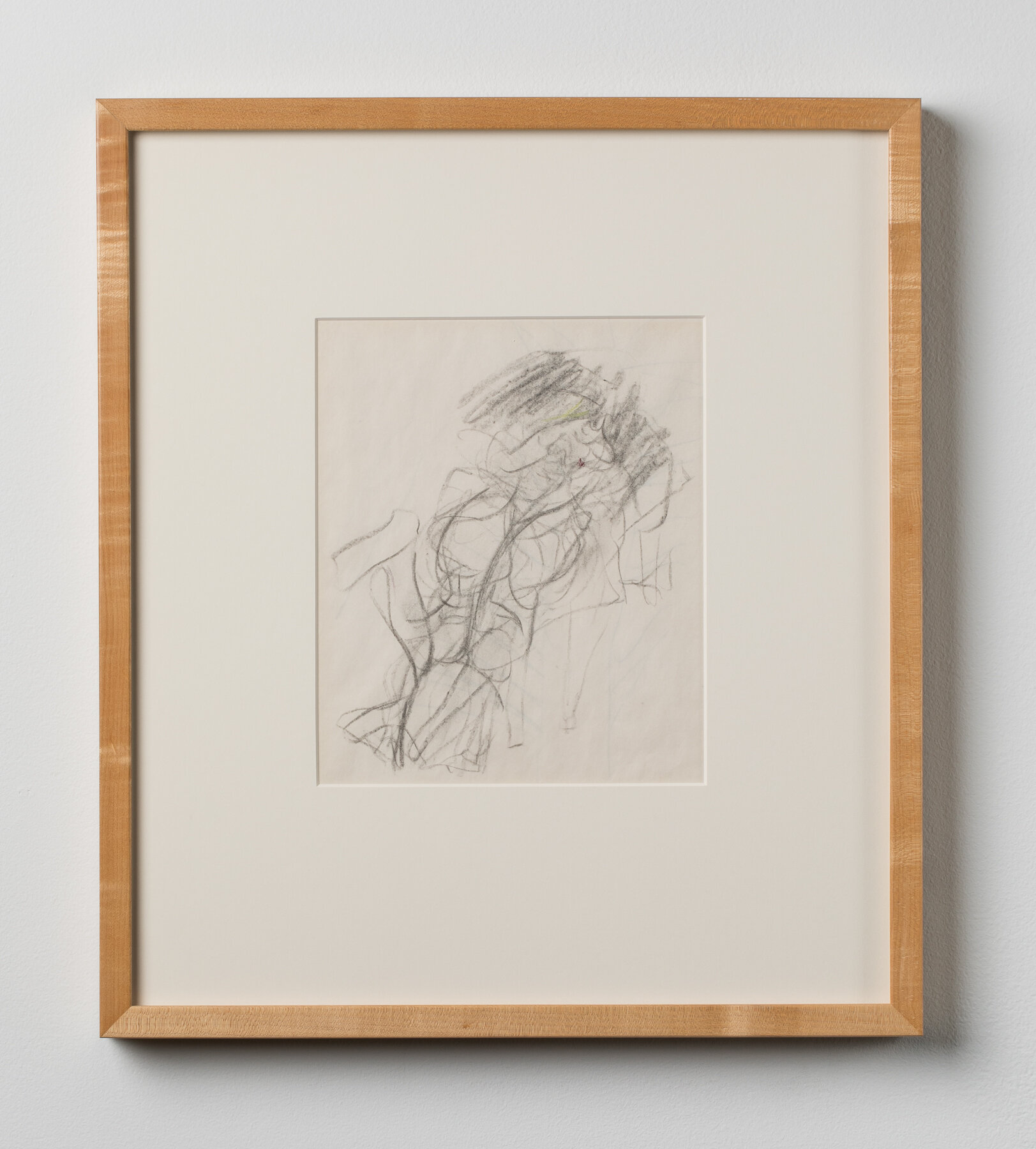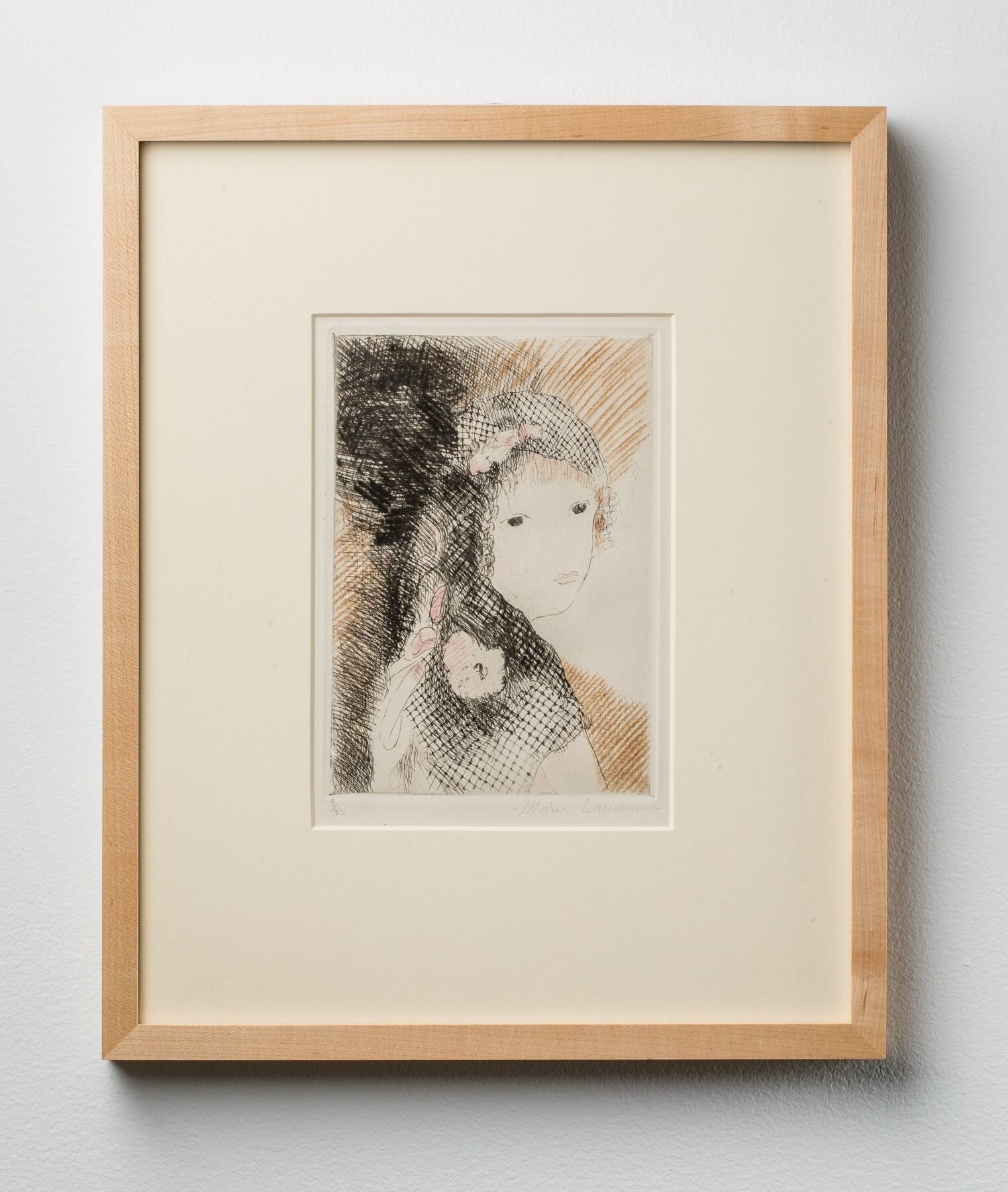
Figural Continuum
Sir Stanley William Hayter 1901-1988, England Floating Figure, 1965 Color viscosity, ed. 27/50 Acquisition Fund HU, 1997, L.L. Inv. Nº 0425
Willem de Kooning 1904-1997, Netherlands Untitled, ca. 1950 Graphite with yellow & red crayon Gift of Samuel Dunais, 1970 Inv. Nº 0359
Marie Laurencin 1885-1956, France Portrait of a Young Girl, date unknown Color intaglio, ed. 9/33 Gift of Dr. H. Kornreich, 1973
Harvey Breverman b. 1934, United States Interior Two Figures with Small Monument No. 1, 1979 Oil on canvas Gift of American Academy & Institute of Art & Letters, 1981 Inv. Nº 0278
Phillip Pearlstein b. 1924, United States Nudes on Striped Hammock, date unknown Intaglio
Loren Hextall ‘16 Seated Women, 2016 Charcoal on paper 91 x 60”
Charles Turzak 1899-1985, United States Chicago Snowstorm, date unknown Woodcut
Mauricio Lasansky b. 1914, Argentina Kaddish No. 5, 1976 Series of eight ed. 29/70 Color intaglio Anonymous gift, 1977 Inv. Nº 0446
Leonard Baskin 1922-2000, United States American Children and Still Life, 1956 Woodcut, ed. 51/210
Edgar Degas 1834-1917, France Manet Seated, Turned to the Left ca. 1865, cancellation proof Intaglio, etching Inv. Nº 0642
Michael Price 1940-2001, United States F. Scott Fitzgerald, 1996 Bronze Gift of Paul Verrett
Diego Rivera 1886-1957, Mexico Fresco study, ca. 1926 Graphite with inscription & poem Gift of Norman Rose, 1970 Inv. Nº 0486
Edvard Munch 1863-1944, Norway Seated Nude, ca. 1909-12 Lithograph Inv. Nº 0768
Fred Hagstrom b. 1954, United States Walking Figure II, 1981 Intaglio
Richard Lindner 1901-1978, United States Untitled, date unknown Pencil drawing Gift of Norman Rose, 1971 Fernand Leger 1881-1955, France Juillet, 1950 Pencil drawing Gift of Simon Askin, 1970
Installation view
Charles turzak
1899-1986
Born in Streator, Illinois, the son of his Czechoslovakian immigrant parents, he did many rural chores as a kid to keep up with his father’s labor-intensive work schedule. Though, he often snuck away to carve miniature animals into peach seeds to sell.
Turzak won a cartoon contest for The Purina Company, which kickstarted his education into the arts and landed him at SAIC. He was primarily a printmaker after graduation.
He traveled to Europe in the early 1920’s and filled books with drawing and watercolor paintings of architecture, boats, skylines, people, etc. He returned to the US at the start of the Great Depression and used his European studies to inspire woodcuts he would create in the future. He also illustrated many books with his woodcuts to earn money.
Marie Laurencin
1883-1956
Marie was born in Paris, France. She first studied porcelain painting early in her career, but later took drawing classes at the Académie Humbert and had her first solo exhibition in 1907. Her lover, Guillaume Apollinaire, coined “Orphism”, an offshoot of cubism, which led her to many other cubist painters of the sort, like Robert Delaunay and Jean Metzinger, that influenced her work greatly.
She was a notable member of Section d’Or, a Paris-based collective of artists associated with cubism and orphism, though she did not particularly express these styles in her work.
sir Stanley William Hayter
1901-1988
Hayter was born in London. He received a degree in chemistry and geology from King’s College London. He later worked in Iran for an Oil Company from 1922 to 1925. When he returned home, he had a show for all the paintings and drawings he made overseas. The success of the exhibition pushed him towards a career in art.
He opened a studio in Paris, Atelier 17, but moved it to New York City at the start of WWII and taught printmaking. Many notable artists like Jackson Pollock, Mark Rothko, and Mauricio Lasansky made prints at Atelier 17 while it was in New York. Hayter returned to Paris in 1950 and took Atelier 17 with him.
His work explores abstraction and is heavily inspired by the surrealism movement.
Edvard Munch
1863-1944
Munch was born in Norway. He’s most famously known for his painting “The Scream”, though he worked in printmaking as well.
After traveling to Paris in 1885, his work became heavily influenced by impressionist painters like Monet and Manet. His main body of work is in post-impressionism style with emphasis on symbolism. He spent most of his time between Paris and Berlin.
Munch created a lithograph print of “The Scream”, along with four other versions of the original painting.
Diego rivera
1886-1957
Rivera was a Mexican painter mostly known for his public murals. At age 12, Rivera’s parents encouraged him to pursue the arts and he enrolled in the San Carlos Academy of Fine Arts. Not long after he finished school, Rivera traveled to Europe to study and was heavily influenced by realism, impressionism, and Spanish painters.
Rivera joined a government-sponsored mural program and his work began to be heavily influenced by his political ideologies. He joined the Mexican Communist Society, founded the Revolutionary Union for Technical Workers, Painters, and Sculptors, and began his mural work centered around Mexican society.
Rivera is remembered as an influence on American public art and his integration of politics in art.
Leonard Baskin
1922-2000
Baskin was an American sculptor, though he is remembered for his works on paper. The illustrative quality of his woodcuts led him to collaborative book work with people such as Ted Hughes and James Baldwin.
In 1942, while a student at Yale, Baskin founded the Gehenna Press, one of the earliest fine art presses in the U.S. that printed over 100 books in Baskin’s lifetime.
His collaborative work with Baldwin included portraits of Baldwin that were featured in a book of his poetry after his death.
Wiillem de Kooning
1904-1997
De Kooning is a Dutch-American artist, born in the Netherlands. He initially left school to apprentice for a firm of commercial artists, but later took night classes at the Academy of Fine Arts and Applied Sciences in Rotterdam. That school is now known as the Willem de Kooning Academie.
In 1927, he moved to Manhattan and began painting in his free time. He joined the Artists Union in 1934 and was employed in the Federal Art Project, which he designed many murals for, though none of them were completed. One sketch was displayed at the Museum for Modern Art in De Kooning’s first group exhibition.
De Kooning is well known for his “Woman” series, Picasso-inspired abstract expressionism work that he started in 1950. The works in this series would take months, even years, to complete. Each work starred a central figure of a woman.
HARVey Breverman
1934 -
Breverman received his BFA from Carnegie-Mellon University in 1956. 5 years later he began teaching at the University at Buffalo where he reinvented the drawing program and created a successful printmaking program.
Breverman taught and visited many universities across the country, including many others all over Europe. He has work in the collections of many museums, such as the Museum of Modern art, the Metropolitan Museum, the Library of Congress, and others.
PHilip Pearlstein
1924-
Born in Pittsburg, Pearlstein gained recognition for his artwork when he was still in high school. He enrolled in the Carnegie Institute of Technology, but was drafted after one year. Upon being discharged from the army, he returned to to school and received his BFA from Carnegie Institute of Technology.
Pearlstein was a graphic designer for Life Magazine. He later became a fine arts instructor at the Pratt Institute, then later a professor at Brooklyn College.
His work has been exhibited in exhibitions throughout the United States. He has paintings in the collections of over 70 public art museums. Pearlstein served as a President of the American Academy of Arts and Letters from 2003-2006.
Mauricio Lasansky
1914-2012
Mauricio Lasanksy was born in Buenos Aires, Argentina on October 12, 1914. He attended the Superior School of Fine Arts in 1933 with an interest in printmaking. He began his career by making woodcuts and later turned to intaglio, concentrating on drypoint. Lasansky was given the opportunity to travel to New York on a Guggenheim Fellowship in 1943. There he studied the entire print collection at the Metropolitan Museum of Art and worked at Atelier 17. Lasansky relocated to Iowa City in 1946 and formed the Iowa Print Group at University of Iowa.
Lasansky is known for large scale work, multiple plate prints, etching, engraving, all sorts of techniques used on copper matrices. He’s explored many different concepts in his work, but usually describes his work by its themes. He’s very expressive, and can be rather colorful, though he has been heavily influenced by those that he worked under in New York and after.
Michael Price
1940-2001
Price grew up in Chicago. He earned a master’s degree in mathematics from the University of Illinois and Champaign-Urbana in 1964. He then served in the Army. He returned to school, earned his master’s degree in fine art from Tulane University in 1968 and was hired to teach in the department of Studio Arts and Art History at Hamline University in 1970.
Price taught art at Hamline University for more than 30 years. He was a sculptor who worked primarily in bronze, casting his work using the lost-wax bronze casting method and was known for his many public installations. He has installations in Minnesota, Illinois, California, Ohio, Kentucky, and Pennsylvania.
Edgar Degas
1834-1917
Degas was born in Paris, France, the oldest of five children. His father pushed him towards law school, but Degas was interested in a career as a history painter.
Degas has become famous for painting, printmaking, sculpture, and drawing. He is thought of as one of the founders of Impressionism, though he preferred to be called a ‘realist’. Much of his work revolves around dance, depicting dancers and movement in his works.
Fred Hagstrom
1954-
Hagstrom has been teaching at Carleton College in Minnesota since 1984. Much of his work is inspired by taking student groups to the South Pacific to study. A lot of his time is spent drawing, though he does not exhibit drawings.
Hagstrom received his BA from Hamline University and MFA from University of Nebraska-Lincoln. He studied under Stanley William Hayter at Atelier 17 in Paris as well. His prints have been shown in galleries throughout the United States and are featured in numerous museum collections, including the Minneapolis Institute of Arts.
Richard Lindner
1901-1978 (top)
Lindner was born on November 11, 1901 in Hamburg, Germany. Lindner’s interest in visual art led him to attend the Kunstakademie in Munich, from 1925 until 1927. In 1929, he became the art director at Knorr & Hirth, a large publishing house, until 1933.
By the 1950s, Lindner decided to focus solely on painting, putting Surrealist and Cubist elements into his paintings of circus women, men in uniform, and people off the street, all of his favorite subjects. His paintings were rendered with bold outlines and harsh colors.
Fernand Leger
1881-1955 (bottom)
Leger was born in Argentan, France. Leger apprenticed as an architect from 1897 to 1899 before moving to Paris in 1900, where he supported himself as an architectural draftsman.
While taking courses at the École des Beaux-Arts and the Académie Julian, he came under the influence of Paul Cezanne, Picasso, and Braque. In 1905, Leger developed his well-known style of tubular forms and mechanical imagery. He went on to create the film Ballet Mécanique in 1924 and design murals for Le Corbusier’s Pavillon de l’Esprit Nouveau in 1925.
His works are held in the collections of The Museum of Modern Art in New York, the Art Institute of Chicago, the Tate Gallery in London, and others.
Loren hextall
Loren is a multimedia artist living in Minneapolis. She received her BA from Hamline University and apprentice taught life drawing in 2016. Much of her work is figural drawings in charcoal and figural paintings.






























